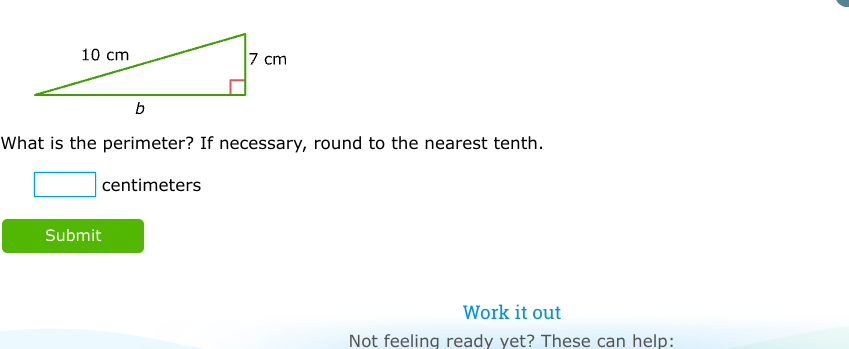What is the perimeter? If necessary, round to the nearest tenth.

Understand the Problem
The question is asking for the perimeter of a triangle given two sides of lengths 10 cm and 7 cm. To find the perimeter, we need to first determine the length of the third side, which can be derived using the Pythagorean theorem since it's a right triangle.
Answer
The perimeter is approximately $24.1 \text{ cm}$.
Answer for screen readers
The perimeter of the triangle is approximately $24.1 \text{ cm}$.
Steps to Solve
-
Identify the lengths of the sides We have two sides of the right triangle: one side is $10 \text{ cm}$ (the hypotenuse) and the other is $7 \text{ cm}$ (one leg).
-
Apply the Pythagorean theorem To find the length of the third side ($b$), we use the Pythagorean theorem:
$$ a^2 + b^2 = c^2 $$
Here, $c$ is the hypotenuse ($10 \text{ cm}$), and $a$ is the known leg ($7 \text{ cm}$). So we rearrange the equation to find $b$:
$$ b = \sqrt{c^2 - a^2} $$
- Substitute the known values Substituting the known values into the equation:
$$ b = \sqrt{10^2 - 7^2} $$
Calculating gives:
$$ b = \sqrt{100 - 49} = \sqrt{51} $$
- Calculate the value of b Now, we compute the square root:
$$ b \approx 7.1 \text{ cm} $$
- Calculate the perimeter Now that we have all three sides, we can find the perimeter ($P$):
$$ P = a + b + c = 7 \text{ cm} + 7.1 \text{ cm} + 10 \text{ cm} $$
Calculating this gives:
$$ P \approx 24.1 \text{ cm} $$
The perimeter of the triangle is approximately $24.1 \text{ cm}$.
More Information
The perimeter of a triangle is the sum of the lengths of its sides. This problem involved the Pythagorean theorem, which is crucial in finding a missing side in right triangles.
Tips
- Confusing which side is the hypotenuse: Always identify the longest side in a right triangle.
- Not squaring the lengths correctly: Ensure that the squaring of numbers is performed accurately.
AI-generated content may contain errors. Please verify critical information